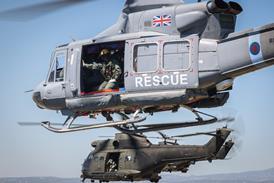Germany's Bodenseewerk Geratetechnik unveiled its Aramis design for an anti-radiation missile (ARM) at the Berlin air show in June. The basic configuration of the dual-mode-seeker, ramjet-powered missile was the result of several collaborative projects with France. This included the SPRINT programme to develop a dual-mode passive-radar/imaging- infra-red seeker.
The aim of the Aramis project, with an in-service date of 2006, was to develop a successor to the French air force's Armat and Germany's Texas Instruments AGM-88 HARM ARMs. The programme, from which France has withdrawn, highlights both the attractions and the problems of opting for a ramjet-powered solution for suppression of enemy air defence (SEAD). An increased range capability can be achieved without a proportionate rise in mass. The Aramis is designed to weigh around 200-250kg, compared to Armat's 550kg or the HARM's 360kg. The Aramis's launch weight is also substantially lower than the only fielded ramjet-sustainer ARM, Russia's Zvezda Kh-31P (AS-17 Krypton), which weighs around 600kg.
The weight difference between the two ramjet designs is mainly the result of their respective design periods, and the tendency for Russian missiles, whatever the application, to be heavier than their Western counterparts. The fact that the Aramis has less mass than the HARM means that the German air force's Panavia Tornado strike aircraft could carry four Aramis missiles rather than the normal two HARM missiles. It would also be feasible to include the Aramis as part of a mixed weapons load on an aircraft for "self- defence", rather than have the platform limited to dedicated SEAD-role missions.
Strike packages could have an integral SEAD capability with several, or each, of the aircraft carrying a single Aramis missile alongside the primary weapons load. Missile cueing could be achieved through the aircraft's on-board defensive-aids system.
The French argue that "second-generation" ARMs can deal with air-defence surveillance radars, but they are poorly suited to aircraft protection in terms of responding to missile-targeting radars. It was this problem which drove the ramjet-sustainer element of the design to provide a greater average speed over the time of flight in comparison to a conventional solid-rocket-powered ARM.
One of the problems for passive-seeker ARMs is that, during the time which elapses between launch to arrival in the target area, the radar emitter is likely to have been turned off. Current ARMs use two techniques to overcome this. The HARM reverts to a memory mode, while the British Aerospace ALARM uses a parachute-loiter mode if the emitter is turned off. The latter method keeps the radar off the air as long as possible and allows an attack it if does begin to emit again.
The USA has no open requirement for a next-generation ARM beyond the HARM, although there are some programmes which may feed into an as-yet "classified" ARM development. The USAir Force and Navy will undoubtedly be looking for a weapon with a greater average velocity than the AGM-88. Russia, despite the parlous state of its coffers, also appears to be looking at ARMs beyond the Kh-31, with ramjet-sustainer propulsion the likely choice of power plant.
Source: Flight International
















